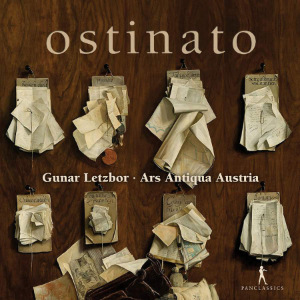
Ostinato
Salzburg Lute Consort
Ars Antiqua Austria/Gunar Letzbor (violin)
rec. 2021, Altemontesaal, Stift St Florian, Austria
Pan Classics PC10444 [73]
My Grove Dictionary defines ostinato as “repetition of a musical pattern many times in succession while other musical elements are continually changing”. In the baroque era, the repeated element was in the bass, whereas now, and I’m thinking here about Philip Glass, it is often the music’s main feature.
Baroque ostinatos turn up in passacaglias, chaconnes (ciacconas) and anonymously in sonatas and the like. A few weeks ago, I reviewed a quite wonderful album on Glossa called Ciaccona! (review) with the same premise as the recording under consideration here. Two works are in common – the Ciacconas by Biber and his teacher, Schmelzer – so I will be able to make a comparative judgement of the two recordings.
For this recording, the five members of the long-standing Ars Antiqua Austria are joined by the Salzburg Lute Consort, adding two more players to the continuo section, giving it real richness and depth.
I feel that it was a mistake beginning with the Biber Sonata, as it is sombre for much of its seven minutes. Don’t get me wrong, it is a striking piece, but as a programme opener, it doesn’t really grab your attention until about four minutes in. Both Biber Sonatas open with a short slow introductory movement, followed by a substantial Passacaglia, the reason for their inclusion. In the case of Sonata 75, the Passacaglia is over twelve minutes long with a tempo marking of Adagissimo, and has a sense of near stasis for most of the time. As good a composer as Biber is, this is quite an ask of the listener.
Perhaps it would have been better to open with the well-known Bertali Ciaccona, where the lovely violin melody and the foot-tapping continuo line immediately engage you. That said, this is the fourth recording I have of the Bertali and it is the slowest by more than a minute, almost two compared to the version on Ciaccona!. I’m not convinced that the steady and deliberate tempo presents this delightful work at its best.
You will have gathered by now that I am having some reservations about the recording, both in the works selected and with the tempos adopted. However, there are still plenty of good points. The appealing Capriccio by Austrian Georg Arnold is a set of variations over an ostinato bass. I’d not heard of him, and so little is known about him, his Wikipedia biography spans no more than twenty-three words, five of those being the full name of the bishop in whose service he worked. Here brevity works in the favour of the piece: thirteen variations are squeezed into the six minutes, and the tempos, while not lively, are more animated than the Biber sonatas. The sonatas by the Polish Heinrich Döbel (he doesn’t even have a Wikipedia page) and Austrian Josef Vilsmayr have one movement with ostinato, allowing us to hear them in the context of the full works. Again, however, the dominant tempo is slow. Finally the Schmelzer returns to an ostinato-only work, and I think this is the best performance on the disc. Again it is slower than the Glossa version by one minute in six, but the beautifully rich sound provided by the extra lutes compensate for that.
The sound quality is very good, and the notes written by Gunar Letzbor are informative, though it is a shame to see a minor typo had been missed by the proofreader: Bertali’s year of birth is given in the booklet and backcover as 1695, rather than 1605.
There are enough good things here to make it worth your consideration, but I feel that the dominance of slow, plodding tempos are a negative.
David Barker
Help us financially by purchasing from



Contents
Heinrich Ignaz Franz Biber (1644-1704)
Violin Sonata VI
Georg Arnold (1621-1676)
Capriccio
Heinrich Biber
Sonata 75
Antonio Bertali (1605-1669)
Ciaccona
Heinrich Döbel (1651-1693)
Sonata in A major
Johann Josef Vilsmayr (1663-1722)
Sonata
Johann Heinrich Schmelzer (c 1623-1680)
Ciaccona


















